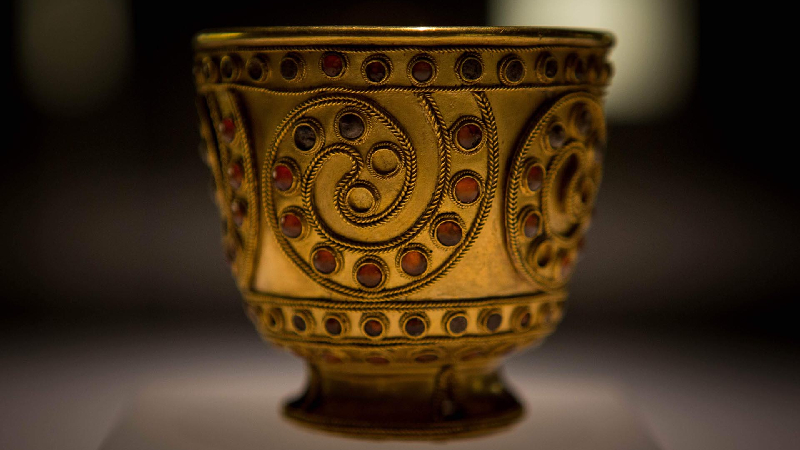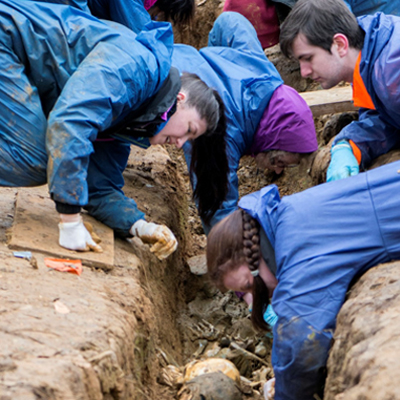
Analysis of more than 4,500 Bronze and Iron Age objects has revealed how gold went out of fashion, suggesting gold artefacts were regarded for centuries as excessive display or ‘bling'.
Work by Dr Nathaniel Erb-Satullo, Lecturer in Archaeological Science at Cranfield Forensic Institute (CFI), has revealed how gold was rejected for hundreds of years by societies which had previously been at the centre of the world’s gold mining and gold-working arts.
The research was based on gold objects from 89 sites in Georgia, Armenia, and Azerbaijan (a region collectively known as the South Caucasus) using geospatial analysis and archaeological evidence – including findspots, quantities, dates, and working techniques – to test different explanations for the rapid decline in the use of gold across a significant part of the region.
Dr Erb-Satullo combed through more than 120 years of published data on gold objects dating from 4000 to 500 BC, ranging from beads and figurines to a goblet inlayed with precious stones and other materials.
The data revealed a steep decline in gold from 1500-800 BC in areas which had previously developed a highly complex and elaborate gold metallurgical tradition.
Reflected in myths of Jason and the Argonauts
The Caucasus was one of the earliest places in the world to develop a complex gold-working tradition and its reputation for gold wealth is reflected in the ancient Greek myths of Jason, the Argonauts and the Golden Fleece.
Dr Erb-Satullo said: “The findings suggest that rather than any shortages, the abandonment of gold was due to cultural factors. The way that gold objects were used in society provided clues as to the nature of this social rejection. In the centuries leading up to the decline, gold was increasingly used to emphasise extreme status differences, for instance in large burial mounds filled with elaborate grave goods. When the social acceptability of this kind of ‘conspicuous consumption’ shifted, the use of gold was rejected along with other elements of this social tradition.
"People still buried their dead with an array of grave goods and social differences were still visible, but huge, ostentatious burial mounds disappeared, and gold is noticeably absent. In general there was a turn away from a social order that emphasised elite individuals towards one that centred political and religious institutions, manifested by the appearance of monumental fortresses and sacred shrines.”
Spatial modelling of access to gold deposits showed that there was no correlation between ease of access to ore deposits and the magnitude of the mid-2nd millennium BC decline, suggesting that loss of access to gold sources was not a prime cause.
Genetic data and other archaeological evidence shows no sign of major demographic disruption that characterises other cases of social collapse and ‘technological loss’. If anything, the evidence shows population expansion, economic prosperity, and innovation in metal technologies other than gold.
Technological development not always linear
The research also shows that technological development does not always follow predictable linear sequences from simple to complex, and sheds light on how and why societies stop using technologies.
The findings reinforce a growing consensus that the spread of innovations is anything but inevitable; rather it is heavily influenced by social factors.
“Technological ‘firsts’ attract a lot of scholarly and popular attention,” added Dr Erb-Satullo, "but technological ‘lasts’ – instances of abandonment and rejection – are arguably more informative about human technological behaviour. By looking at how technological systems break down, we can better understand how they develop and spread. An analogy would be that many of us never really understand how a piece of technology – our cars, our electronics, the software code we use every day – works until it breaks, and we have to figure out what went wrong and fix it.
"This study shows that social factors play a major role in the collapse of technological systems, and that such systems are not inherently self-sustaining. The loss, abandonment, and rejection of technologies occurs in a range of circumstances that have not been highlighted by prior research. Societies may reject technologies even after widespread adoption if the foundations cultural acceptability shift."
The full paper – ‘Technological rejection in regions of early gold innovation revealed by geospatial analysis’ – is published in Scientific Reports here.
Notes for editors
About Cranfield Forensic Institute
Cranfield Forensic Institute (CFI) has a long history as a centre for innovation, expertise and strong student community.
CFI was established as the home for the many forensic-related disciplines already active at Cranfield University, including ballistics, explosives, materials science, engineering failures and forensic computing. These were greatly enhanced by the addition of forensic archaeology and anthropology, making Cranfield the only university in the world to accommodate these disciplines within a science and technology faculty.
CFI has become a leading international player in the field known for the best research and postgraduate teaching. We significantly enhance the employability of students by producing postgraduates of the highest quality. Students have opportunities to join existing research teams, study overseas and produce research papers and alumni have gone on to work around the world for a multitude of public, private and government services.
Recent investment of over £7 million into the latest analytical equipment, teaching spaces and experienced and industry relevant academic staff – targeted in the fields of crime scene investigation, digital forensic investigation and especially forensic and archaeological materials analysis – has created a UK centre of excellence with facilities among some of the very best in the world.
About Cranfield University
Cranfield University is a specialist postgraduate university that is a global leader for education and transformational research in technology and management.



